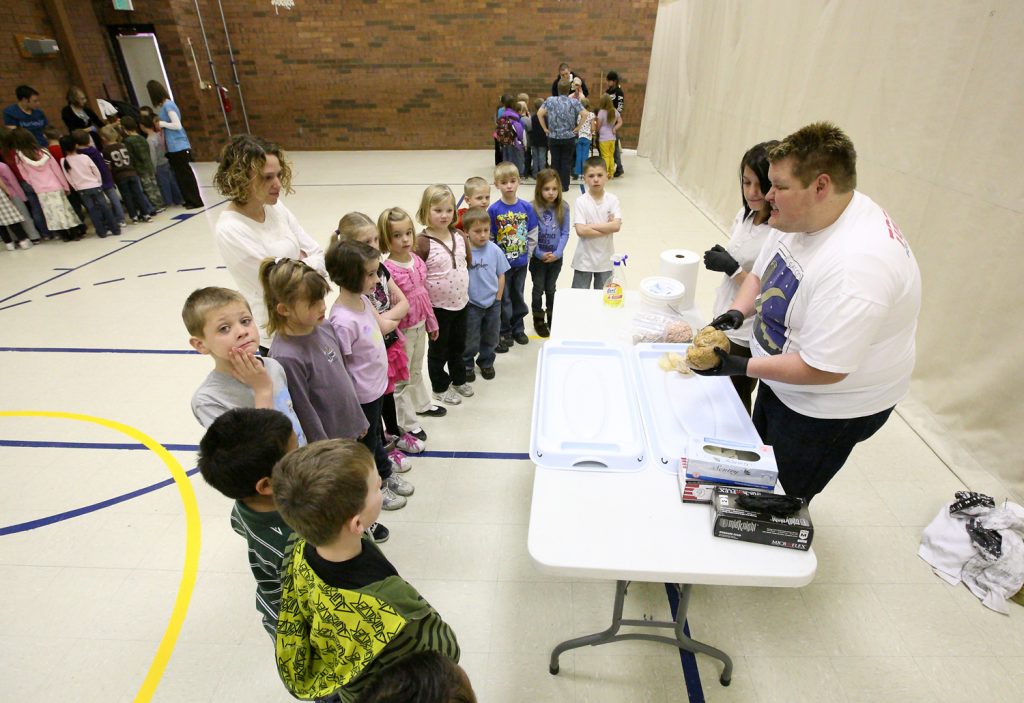1,300 elementary students learn biology 1010
Think how cool it would have been when you were in elementary school to see, smell and touch actual body parts of humans and animals. Students in the Carbon School District elementary schools got to do just that, thanks to USU-CEU biology associate professor Tyson Chappell, Ph.D.
Chappell took some of his students to all Carbon District elementary schools for the USU Eastern Elementary Biological Science Exploration from March 7 – 10 from 8 a.m. to 3 p.m.

This archived article was written by: kelli Burke-Gabossi
Think how cool it would have been when you were in elementary school to see, smell and touch actual body parts of humans and animals. Students in the Carbon School District elementary schools got to do just that, thanks to USU-CEU biology associate professor Tyson Chappell, Ph.D.
Chappell took some of his students to all Carbon District elementary schools for the USU Eastern Elementary Biological Science Exploration from March 7 – 10 from 8 a.m. to 3 p.m.
While Jon Krum, Ph.D., had the original idea, Chappell planned the event. He has taught at the elementary schools in previous years for his children’s grades. Krum thought that they should expand on this learning experience.
Chappell and his anatomy assistants visited grades two through six for Castle Heights, Wellington, Creekview, and Sally Mauro Elementary schools. The first grade class from Castle Heights was also included in the workshop.
“I thought that it would be much more beneficial to let small groups of students actually get to see and hold and unfortunately smell the science of anatomy and physiology up close. So each grade was broken down into four groups which then rotated through the tables for 15 minutes each,” Chappell said.
USU Eastern students involved were: Trisha Larson, Kelton Wells, Corey Roberts, Daniel Quick, Hannah Lartey, Sheridan Hewitt, Miranda Gold, Kaitlyn Reaves, Laren Kulow, Julie Mathews, Kristie St. Pierre, Jennifer Chiara, Sarah Kenison, Kaitlin Reeves-Taylor and Tanner Hackney. They talked for five to six hours straight each day. “I’m happy we did it. It was a lot of work, but my students held strong,” stated Chappell.
Four booths were set-up to display body parts: 1) human brain, sheep brain and cow eye; 2) elk heart, pig heart and sheep heart; 3) plastic torso model for the structure and function of the basic internal organs; and 4) plastic bones. Chappell’s students discussed the anatomy and physiology of certain organs as well as the different regions of the brain that are responsible for personality, higher cognitive processing, thoughts, dreams, the cortical areas responsible for our senses of touch, smell, vision, audition and more.
The elementary students reacted positively for the most part. According to Chappell, a few students did not seem to enjoy the workshop; a small percentage became a little sick and light headed; only two threw up; and nobody fainted. There were about 1300 students in all that were able to participate in the demonstrations.
“I hope they’ll be more interested in science. We hope we left a good impression. We’ve heard a lot of positive feedback.” They have received e-mails of thanks from parents. According to Chappell, the elementary students learned a lot. “They seemed really interested and asked really great questions.”
Chappell expects next year’s subject to be chemistry or physics. They’d like to rotate the subject each year. It was a very positive way to spend spring break.




